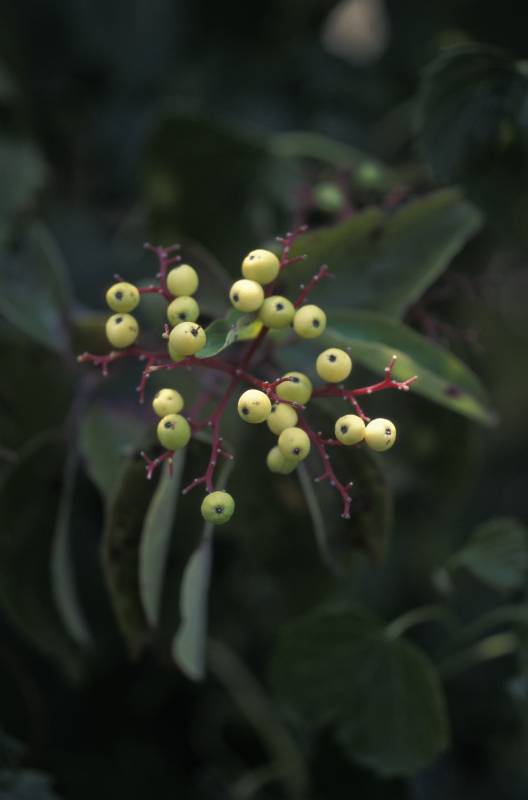Effects on Natural Communities
Gray dogwood is a native shrub that is a natural component of many woodland and prairie communities. Eradication of this plant is not practical nor desirable. Managers who are concerned by the abundance of gray dogwood on a particular managed area should determine the desired abundance of the shrub on the site before setting goals for control. A sequence of historical aerial photos can be helpful in confirming or refuting the belief that this shrub is increasing coverage at the expense of prairie ground cover on a given site. Knowledge of appropriate levels of shrub cover will allow informed decisions regarding the need for control.
By crowding out native prairie grasses and forbs, gray dogwood can reduce the habitat available for a prairie ground cover. In Missouri, gray dogwood is considered a problem in remnant loess hill prairies of the northwest because it reduces the size of these already diminished communities. In the western U.S., this shrub has invaded former river channels, thus reducing the channel area following water diversions.

Control measures may enlist one or more of the following techniques: prescribed burning, cutting, or herbicide treatments. No biological controls are known. Although grazing is used in management of some Missouri prairies, it is not felt to significantly affect the growth of gray dogwood.
Title
Mechanical Control
Prescribed burning
No consensus of opinion was found for optimum time to burn for gray dogwood control. Re-sprouting is likely following fire; and if sufficient fuel is not available for annual burning, then root reserves may soon be replenished to pre-burning levels. Fire is probably more effective when combined with cutting and/or herbicide treatments.
Cutting
Cutting twice within a growing season combined with prescribed burning after re-sprouting will significantly weaken this shrub. Summer cutting and herbicide application followed by burning the following spring (after bud break) is reported to give control. After a stand has been reduced to an acceptable level, cutting and burning alone should maintain the desired level of abundance.
Title
Chemical Control
As cut stem treatments, both glyphosate (Roundup) and triclopyr have proven effective. A 10- to 20-percent solution in water of either chemical can be painted on stems immediately following cutting during the summer. The higher concentration may be necessary for the larger stems. Mowing of shrubs with a later foliar application of a 1.5-percent solution of glyphosate resulted in 100-percent control of the related rough-leaved dogwood. Ammonium sulfamate (AMS), trade name Ammate X-NI Weed and Brush Killer, has also produced 100-percent control when painted on cut stems in an Illinois study. As concentrate a solution as possible in water was painted on gray dogwood stems immediately after cutting in February. (Note: some products containing glyphosate or another herbicide may be pre-diluted, so be sure to read product labels to understand herbicide concentration levels).
At a Missouri loess hill prairie in Atchison County, gray dogwoods were cut and cut stems treated with Tordon RTU in April. The area was burned the following spring. This combination of cutting, chemical stem treatment, and burning was effective in areas where prairie vegetation carried the fire. Dogwoods that were not surrounded by prairie vegetation were not impacted by the fire and were re-sprouting vigorously two years later. A thin-line basal bark application of Garlon 4 in March has been used at this same site, but results are not yet available. The thin-line bark treatment allows treatment of a larger number of stems in a shorter time period than the cut stem treatment.
The recommended method of chemical control is the use of glyphosate or AMS because of their relatively low toxicities, lack of persistence in soils, and effectiveness in gray dogwood control. By law, herbicides may only be applied according to label directions.
Title
Failed or Ineffective Practices
Gray dogwood is topkilled by fire but re-sprouts readily. Prescribed burning will probably be ineffective in well established stands unless repeated frequently or accompanied by cutting and herbicide application.
Cutting and treating stems with Tordon RTU in April was ineffective in northwest Missouri, except when followed by a prescribed burn the following spring. Thickets with too little fire-carrying fuel re-sprouted vigorously.





















